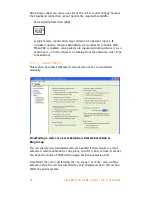
T A L K S W I T C H C O N F I G U R A T I O N
6 7
1. Busy tab — routing options when this extension is busy
Cascade options for forwarding calls:
•
go to voice mailbox,
•
go to local ext.,
•
go to remote ext.,
•
go to ring group,
•
play announcement,
•
go to auto attendant,
•
play busy tone (example, if a fax machine is at the extension),
•
hang up.
For more information on these features, see Chapter 3:
Using TalkSwitch.
2. No Answer tab — routing options if this extension is not answered
after x rings
Select the number of rings and select one of the actions. The action drop
down list is the same as for the Busy tab except that the option ‘play busy
tone” is replaced by ‘keep ringing‘.
3. Answered tab — routing options when this extension answers or ‘rejects’
a screened call
Select ‘play caller’s name first’ to prompts callers who choose this
extension at the Auto Attendant, to record their name. When you answer
the call at the extension, it announces the caller (by playing their
recording). At this point, you can accept the call by pressing
or
reroute the call to the Cascade options on this tab by hanging up or
pressing .
Routing/forwarding options for rejected calls:
•
go to voice mailbox,
•
go to local ext.,
•
go to remote ext.,
•
go to ring group,
•
play announcement,
•
go to auto attendant,
•
hang up.
If you select ‘stay connected’, the Call Cascade options are grayed out.
TalkSwitch can control forwarded calls when prompting is enabled. If you
use one of the prompted methods for this Remote Extension, have Music
on hold enabled and are not using 3-way calling to forward calls to this
Remote Extension, the Call Cascade is seamless to the caller. S/he only
hears music throughout the entire process of trying to locate you.
#
*
















































